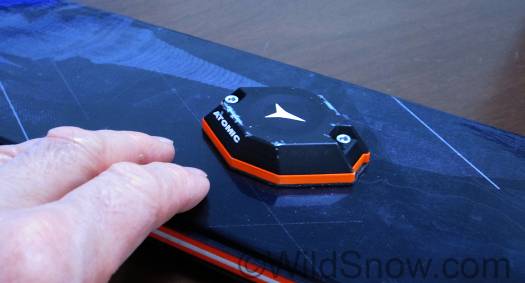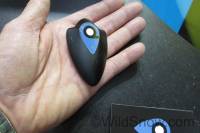
Ski Tracer by Atomic sticks to your ski with double sided tape. Screws are for changing battery once a season.
Strapless, braless, broless, brakeless? Not sure about some of that, but in the case of ski brakes, it’s become common to just leave the pesky things home — or buy bindings that don’t have any in the first place.
The usual evolution is first you use brakes, then convert to straps for less weight. You then hassle with the straps for an average of 4.6598 years and realize you rarely fall, a ski comes off perhaps once every 2.9856 years, and you leave your straps home as well. Then one fair day you exceed the 2.9865 average and a ski snakes away under the powder like a python chasing a rabbit, leaving you probing around with a ski pole grip like, well, an idiot. That’s a situation that could go from funny to call-the-helicopter real quick, depending on time of day and how remote you are.
I’m thus excited to mention several companies will be retailing what appear to be effective devices for finding a lost ski using radio and audio signals. Yes Virginia, this gimmick has been tried before but nothing leaped out at me over the years; now these two products appear to have promise. (If you actually know of a ski finder that truly works and is small and light enough to be reasonable, feel free to comment.)
First up, the Ski Tracer from Atomic is a Bluetooth radio signal locating device. Ski Tracer weighs much less than a ski brake (30 grams), the batteries last a season (easy replacement), and the unit installs on your ski in minutes with adhesive backing. Along with the device ostensibly directing you to the lost ski, from the phone app you can also turn on a loud sound signal that comes from the device on your skis. Preliminary opinion is these are a powder cat’s meow. Use the lightest bindings you want, melt down your ski brakes for scrap, and enjoy the float.
Atomic Ski Tracer Specs:
Bluetooth device, continuously transmitting.
Range 50 meters if ski buried 1 meter.
30 grams each.
Euro MSRP 79.99€ , but North America won’t be too far off that. Fall 2015 delivery
Range- 50 meters, with a depth of 1 meter under snow
Glass Fiber reinforced Polyamide housing
2430 button battery
Internals engineered by Suunto
Luckily I was doing rounds at ISPO Munchen and spied the Powunity Neverlose. Any company that uses compound words for product names has to be good and hightech, right? So this caught my attention. Neverlose pairs with a Bluetooth device, probably your smartphone, but a keychain type controller will be available as well. If your skis are stationary outside the coffee shop, you can switch to anti-theft mode and a 100 dB alarm sounds if the skis are moved. Out in the wild, if your ski comes off and ends up some distance from your paired smartphone, the loudness is triggered and you find your plank. The Neverlose is noticeably smaller than the Ski Tracer and probably weighs slightly less. I’m not sure of any direct tradeoffs between the devices. Both appear to be good ideas and will need some field testing.
Something to at least watch, and perhaps early adopt. In the latter case be sure to attend our WildSnow early equipment adopter’s help group before you get too crazy.
Caveat with these devices is of course you still need brakes and/or safety straps in hard-pack conditions, especially at the resort where a lost ski could skewer someone. More, without brakes, even in powder conditions an errant ski can do quite a TGR movie worthy freeride without you as a passenger. So we’d only recommend these for skiers who rarely throw a shoe. But I’ve seen situations all over the world where these things would be ideal.
WildSnow.com publisher emeritus and founder Lou (Louis Dawson) has a 50+ years career in climbing, backcountry skiing and ski mountaineering. He was the first person in history to ski down all 54 Colorado 14,000-foot peaks, has authored numerous books about about backcountry skiing, and has skied from the summit of Denali in Alaska, North America’s highest mountain.

